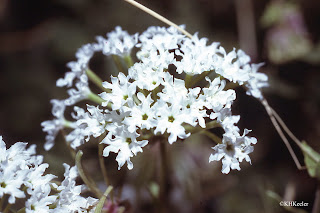My common name for Abronia fragrans is prairie snowball, but the USDA website prefers snowball sand verbena and the Flora of North America calls it fragrant white sand-verbena. It is a small perennial plant in the family Nyctaginaceae (the family of four o'clocks and bouganvillea), native to the central U.S. plains (Distribution link).
I first encountered it at the University of Nebraska's Cedar Point Biological Station north of Ogallala, NE. We'd play volleyball after dinner beside the dining hall. About the time we were quitting one evening, I smelled a lovely scent. I circled our sandy playing field and found a scruffy little plant with long tubular white flowers. The scent reminded me of lilacs.
Waiting for the scent on subsequent nights, I found that it was released about 7 pm, which wasn't quite after dark standing in the open, but quite dark in shade of the field station's slopes.
The white flowers and strong scent suggested nocturnal pollination by a moth. (It could also indicate pollination by bats, but pollinating bats don't occur in west-central Nebraska.) I watched for moths but it was a year or more later that, with the help of student Myra Fredricks, we caught a moth visiting the flowers and showed that prairie snowball was indeed moth-pollinated. (See References).
In keeping with the typical characteristics of moth-pollination, the flowers are limp and nondescript during the day, but as it gets dark, they expand into a series of frilly white trumpets, each about an inch long. Then, later, the scent is released.
Studies of pollinators following a scent shows that they fly across it. When they can't smell it, they turn and fly at an angle until they intersect the smell. Comparing the intensity of the smell in two places tells them which direction to fly. This zigzagging flight path leads them to the source of the fragrance.
Typically, lists of the plants of the plains don't comment that prairie snowball is night-blooming. Perhaps the writers thought it unimportant, but more likely, they don't personally know this particular plant and only saw it as a dried specimen. Or, perhaps they came upon it on a cloudy morning and did not realize it had opened the night before: nocturnal flowers wilt in heat and light, but cool cloudy days extend their visibility.
 |
| Prairie snowball, early morning |
 |
| A sand-verbena, Abronia, from the coast of California |
 In 30 years of working in western Nebraska, I came upon prairie snowball only a couple of times. The one I clearly remember was a big plant in the corner of a small corral where cattle were briefly penned before loading them onto trucks. The sandy soil had been terribly churned up but not recently.
In 30 years of working in western Nebraska, I came upon prairie snowball only a couple of times. The one I clearly remember was a big plant in the corner of a small corral where cattle were briefly penned before loading them onto trucks. The sandy soil had been terribly churned up but not recently.The wild plants remain a fond memory and so I would happily raise prairie snowball in my garden. Once in the last decade, one of the native plant seed companies had prairie snowball seed. I bought it and put it in my garden, but in several years, nothing has come up. I thought they would be weedy enough to germinate easily but that was not the case. It is possible they have a long dormancy period and one of these years seedlings will appear, but I don't count on it. I watch the seed companies like a hawk in hopes one will sell prairie snowball seeds again. If they do, I'll go to a great deal more effort to create conditions favorable for the seeds to germinate.
A grand little plant, not easy to find.
Comments and corrections welcome.
References
Keeler, K.H. and M.S. Fredricks. 1979. Nocturnal pollination of Abronia fragrans (Nyctaginaceae). Southwestern Naturalist. 24: 692-693.
Kathy Keeler
More at awanderingbotanist.com


I have one of these growing on our property. We live on a huge cattle ranch. But this grows near my home.
ReplyDeleteI have seen it before but I don't always notice it. So I'm not sure if it comes back every year.
I will watch for seeds. I think the smell is similar to Jazmine.
Thanks for the info.
Mitzi
I bought some seeds from Plants of the Southwest and broadcast them in a bare sandy spot on winter, then watered regularly through spring. They are now blooming.
ReplyDeleteI live in Colorado Springs